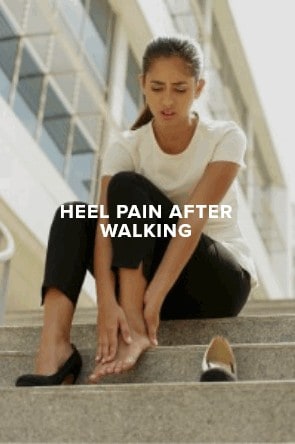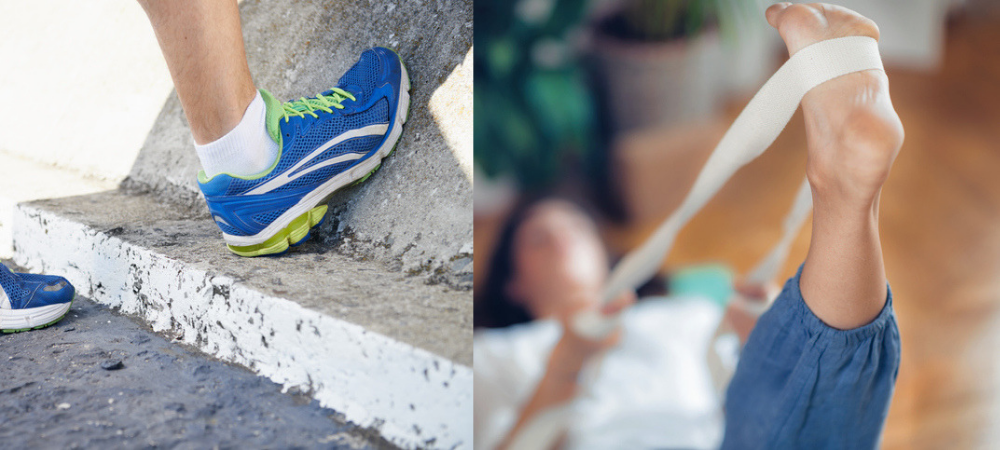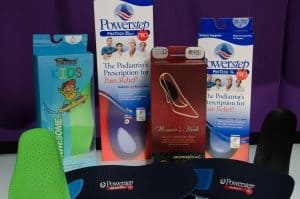Heel Pain & Heel Spur

Heel Pain & Heel Spur Treatments, Pittsburgh Area
Heel Pain & Heel Spur
When heel pain strikes, it can be debilitating. Many people with heel pain or heel spurs in Pittsburgh, can’t walk—let alone enjoy an active lifestyle—because it can be so painful. But, using state-of-the art technology, Dr. Christina and her staff at Beaver Valley Foot Clinic can resolve your Plantar Fasciitis, or heel pain, and you can regain your life!
Why Are You Experiencing Heel Pain or Heel Spurs?
Heel pain and heel spurs can often be aggravated by your job, your weight, your age, and your choice in shoes. These factors can cause pain in your heel:
HEEL PAIN AFTER WALKING
- Weight
- Activity level
- Increasing age
- Overall general health
- Sports injuries
- Unsupportive footwear
Who Is Most Susceptible to Heel Pain and Heel Spurs?
- People who lead an active lifestyle, such as athletes
- People who must stand and walk a lot for work
- Women who have just started a walking program to get in shape
Where Is the Heal Pain Located?
- Pain under the foot( where the arch meets the heel bone: Plantar Fasciitis
- Plantar Fasciitis (sometimes called a heel spur), is a painful heel condition that inflames the bottom of the foot when a ligament that runs from the heel bone to your toes becomes strained.
- Pain behind the heel: Achilles tendinitis
- Achilles tendonitis occurs when tissue connecting your lower leg’s calf muscles to your heel becomes overused, causing heel pain. Runners frequently experience Achilles tendinitis.
What are heel spurs?
Long standing irritation can cause formation of calcium deposits at the point where the plantar fascia inserts into the heel bone. The result is the appearance of a heel spur on x- ray. The spur itself is not the cause of pain. The terms heel spur syndrome and plantar fasciitis are often used interchangeably in medicine, and the cause and treatment for the conditions are the same.
Heel Pain & Heel Spur Solutions
Heal pain problems, in some cases, can be resolved through traditional conservative therapies like orthotics, exercise, ice, physical therapy, cortisone injections, or anti-inflammatory medications. However, sometimes heel pain can’t be resolved through these remedies.
How is heel pain treated in Runners?
There are many treatments for heel pain, Pittsburgh.
At the first sign of pain in the arch or the heel, consider the following:
- Shoe recommendation/ modifications like proper shoes for your activity.
- Rest. Take a few days off or decrease training.
- Cross-training activities like swimming, walking, elliptical, or biking helps rest the aggravated area
- Taping for biomechanical treatments helps temporarily.
- Ice the area. Apply frozen veggies for ten – twenty minutes after activity or after work.
- Stretch (toes to nose) before getting out of bed in the morning and several times through out the day after resting or driving.
- Wear shoes at home inside the house- do not go barefoot.
- NSAIDs (non-steroidal anti-inflammatory drugs) give temporary relief.
- Cortisone injections.
- Physical therapy modalities
- Custom molded orthotics
- ESWT for treating heel pain.
- Surgical options are a last resort.
If you think you may have heel pain or plantar fascia pain, Pittsburgh, you can CONTACT US for assistance 878-313-3338 to find the nearest Beaver Valley Foot Clinic office in your area.
Extracorporeal Shockwave Therapy for Plantar Fasciitis
Extracorporeal Shock Wave Therapy, or ESWT, is a noninvasive alternative to painful surgeries. It treats chronic plantar fasciitis as a cause of heel pain. This is an excellent office procedure when all other conservative methods have failed!
Surgery is the best option for a rupture of the Achilles Tendon, which is characterized as pain on the back of the heel
Achilles tendon rupture cannot be solely treated with OTC medications, physical therapy, and heel lifting devices. If you feel a sudden “pop” or like you were shot in the back of the leg or can’t stand on your tip toes, surgery is sometimes needed. If your Achilles tendon has ruptured, you may need surgery that will attach your tendons back together, and will then have a cast for six to 10 weeks.
Images of arch supports and orthotics
We have arch supports and orthotics
Heel pain in 10-12 years olds -diagnosis and treatment
Commonly occurring in boys of 10 to 12 years old and 8 to 10 years old girls, Calcaneal apophysitis often occurs during or after a growth spurt and at the start of sports seasons. Your child may complain of pain during or after running and jumping activities. Tight Achilles tendons or plantar fascia, along with overuse, high-impact sports, improper footwear and uneven training surfaces all may lead to heel pain in children. The “squeeze test,” involves squeezing the bone of the heel medially and laterall y causing compression over the growth plate which is called the apophysis, causing pain. Treatment may include decreased running and increase cross-training activities until the pain diminishes.
If you are experiencing plantar fasciitis or heel spurs, or any type of heel pain, call Beaver Valley Foot Clinic’s 4 convenient locations today at 878-313-FEET (3338) so that Dr. Christina can assess your situation, administer treatment, and get you back on the road to feeling good again!
Click Here to E-mail Dr. Christina Teimouri
HOURS OF OPERATION BY APPOINTMENT
- Before and after work and lunchtime appointments available
- Emergency appts reserved for Weekend, same day and evenings.
Why choose us as your Allegheny, Beaver or Butler County Foot Care Office?
- Podiatry clinics in Ambridge, Moon, Bridgewater and Cranberry
- Surgically Board Certified by ABFAS
- Practicing 23+ years!
- Options that fit each patients needs
- Non-invasive options others don’t have
- We cater to cowards
- Boarded and Certified very friendly assistants
Heel Pain
Pain in the heel may be plantar fasciitis which is caused by irritation or inflammation of the plantar fascia on the bottom of your feet. It typically produces the most pain in the morning when getting out of bed. It can be felt in the arch or heel of your feet.
To treat it:
- Rest your feet
- Do heel and foot stretches for the surrounding muscles
- Take over-the-counter pain relievers such as NSAIDs
- Wear shoes with good support and a cushioned sole.
Heel spurs are another common source of foot pain. They are caused by abnormal growths of bone in the bottom of the heel. It can occur via abnormal gait or posture, as well as wearing the wrong shoes or running. Spurs can be painful while walking and standing. Most people do not experience pain symptoms with heel spurs. Individuals with flat feet or high arches are more at risk for heel spurs.
To treat heel spurs:
- Wear a cutout heel pad
- Use a custom-made insert (called an orthotic)
- Wear shoes that fit well and have shock-absorbing soles.
- Take over-the-counter pain relievers such as NSAIDs
- Rest
- Physical Therapy
- If you still have pain, ask your doctor about medical procedures.
A stone bruise is identified as a deep bruise of the fat pads of the heels or balls of the feet. This most often occurs from an impactful injury, but may also happen if a hard object is stepped on. The pain has been described like walking on a pebble, and it will gradually subside with time.
In the meantime:
- Rest your foot.
- Ice the area.
- Take over-the-counter pain relievers.
A heel fracture is usually caused by a high-impact injury such as a fall or car accident. Your heel bone may break or shatter. Heel pain, bruising, swelling, and trouble walking are the most common symptoms of a heel fracture.
To treat it:
- Do not put pressure on the heel. Crutches are recommended
- Protect the heel with pads.
- Wear a splint or cast to protect the heel bone.
- Ask your doctor about over-the-counter or prescription pain relievers such as NSAIDs
- Physical Therapy
- If you’re still in pain, ask your doctor about surgery.
Are there non-surgical treatments for heel spurs, and how effective are they?
Yes, there are non-surgical treatments for heel spurs that can effectively alleviate pain and discomfort. These treatments may include:
- Rest: Giving your feet time to rest and heal can be effective.
- Ice: Applying ice to the affected area can help reduce inflammation and pain.
- Stretching exercises: Stretching the calf and Achilles tendon can relieve tension on the heel.
- Orthotics or shoe inserts: Custom or over-the-counter inserts can provide better arch support and cushioning.
- Anti-inflammatory medications: Nonsteroidal anti-inflammatory drugs (NSAIDs) can reduce pain and inflammation.
- Physical therapy: Exercises and techniques provided by a physical therapist can improve heel pain.
How can one differentiate between heel spurs and other causes of heel pain, such as plantar fasciitis?
- Location of Pain:
– Heel Spurs: The pain from heel spurs is typically located at the front and bottom of the heel, often beneath the heel bone.
– Plantar Fasciitis: Plantar fasciitis pain is generally concentrated on the bottom of the heel and often radiates along the arch of the foot.
- Onset of Pain:
– Heel Spurs: Pain from heel spurs may develop gradually and become more persistent over time.
– Plantar Fasciitis: Plantar fasciitis pain often begins suddenly, especially after activities like waking up in the morning or after prolonged periods of rest.
- Contributing Factors:
– Heel Spurs: These are often associated with prolonged stress on the heel bone, such as from running or repetitive activities.
– Plantar Fasciitis: Tight calf muscles, obesity, high-impact sports, or improper footwear can contribute to plantar fasciitis.
- Imaging:
– Heel Spurs: A diagnostic X-ray may reveal the presence of a heel spur.
– Plantar Fasciitis: While plantar fasciitis is often associated with heel spurs, it can be diagnosed clinically based on symptoms and physical examination.
Is Heel Pain Worse In Morning? Why it Happens?
Yes, heel pain can get worse in the morning especially if you are suffering from conditions like plantar fasciitis. This can usually happen because when you are asleep, the plantar fascia (the band of tissue connecting the heel bone to toes) will tighten up. That’s why when you wake up. And take the first step of the day, the sudden stretch of plantar fascia will cause sharp pain and discomfort, which makes heel pain worse in morning. If you experience such symptoms, you might be suffering from plantar fasciitis rather than heel spurs.
Fortunately, the pain will decrease throughout the day as you move since it loosens the fascia. But if you stay inactive fir long period, you will experience the shock of pain yet again.
How Does Plantar Fasciitis Related With Heel Pain?
One if the most common causes of heel pain is usually plantar fasciitis. It is a condition where your plantar fascia, which is a thick band of tissue used to connect heel to toes becomes inflamed because of excessive pressure, overuse or aging, which leads to development of small tears into it, which causes a lot of pain. Pain from plantar fasciitis is described as sharp, and stabbing sensation, and this is most painful especially at the morning when you take your first step of the day. It happens because all night the fascia was at rest, but the sudden movement at morning stretches it and renews all the tears, which can cause a lot of discomfort. But it also means, this can happen even if you are inactive for too long, so people who are on their desk for too long may experience this lain multiple times!
But plantar fasciitis just doesn’t happen on its own, there are many factors that can contribute to it’s growth or development in the first place, these factors can include obesity, prolonged standing, heavy impact activities, improper footwear and age. Which explains why it’s the most common problem when it comes to heel pain!
Do Heel Spurs Always Cause Pain?
No, heel spurs doesn’t cause pain all the time, in fact many people develop heel spurs without knowing it simply because there’s almost no discomfort at start. But later it starts with inflammation of surrounding soft tissues, which can feel similar to plantar fasciitis. Normally, heel spurs are just calcium deposits that form after long-term strain on foot muscles, and ligaments, but they themselves aren’t painful on their own. Other factors like, excessive pressure, terrible footwear, or standing for too long is want triggers the pain most of the time.
Can Standing For Too Long Worsen Heel Spurs?
Yes, standing for too long actually worsens heel spurs and the pain associated with it. Heel spurs are bony growths on the heel bone, which are often caused by strain on muscles and ligaments in the foot. They develop when pressure is placed on heels for extended periods! Standing for prolonged periods increases stress on start fascia, which leads to inflammation and contribution to formation or aggravation of heel spurs.
Are Heel Spurs Much Mote Common In Athletes?
Yes, that’s right! It’s because heel spurs develops when pressure is applied repetitive in feet, which means activities like running, jumping, dancing, or even those activities that puts constant strain on plantar fascia increase the chances of developing heel spurs. This can lead to inflammation and discomfort, which isn’t great for athletes, which is why they always follow preventive measures to make sure they aren’t hurdled by problems like this. However, if you are new to sports and want to avoid heel spurs at all costs then make sure to follow preventive tips and talk your doctor about it.
FAQ Frequently Asked Questions
What do you do when your heel hurts?
- Call a podiatrist
- Rest until it is evaluated
- Ice the area
- take NSAIDS for comfort
Can Plantar fasciitis go away on its own? Sometimes if you catch it quick enough in the beginning, heel pain can resolve on its own, but if it has been present two weeks or more, get it checked out. It may become chronic, thus harder to treat.



